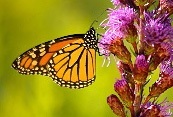
A magnet for butterflies
Photo: © Y.Cunnington
Wildflower meadows of North American native wildflowers and grasses have been billed as a low-maintenance, earth-friendly way of planting that doesn’t call for fertilizers, herbicides, pesticides or extra watering.
But do they really work in practice? Yes, if you start out properly (researching the process and following each step carefully), but like all gardening, it requires effort and money and isn’t entirely carefree.
Mostly, it takes patience – the real show of flowers takes three years to get going. Meanwhile, you will find (as we did) that your neighbors are skeptical.
Why plant a wildflower meadow?
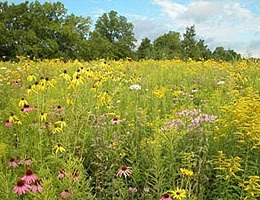
Our wildflower meadow in mid-summer
Photo: © Y.Cunnington
Our planting of wildflowers and grasses (shown here) is an amazing blaze of color each summer.
It’s enormously popular with birds and butterflies, and has become my favorite place to photograph from mid-July to September, especially when the butterflies come.
The idea seemed a natural fit for us after we bought our 10-acre country property in 1998. Our farm had a hayfield on a sunny, open site that was cut each summer by a local farmer.
This field took up more than half of the property, and we wanted to reclaim the land for ourselves. Our plan was to plant trees and shrubs on part of it, and much of the rest would be lawn.
I don’t mind lawn, but planting grass over the entire area seemed excessive, so we decided to add a wildflowers to a two-and-half acre portion of the property.
Wildflower meadows – challenges & logistics
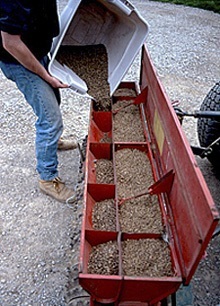
Paul fills seed drill with grass and wildflower seeds
From my research, I knew that one of the big concerns with growing wildflower meadows from seed would be competition from weeds.
Because they are perennials, wildflowers from seed take three to four years to grow to flowering size, and that gives the weeds plenty of time fill gaps between plants. (The area we want to plant was relatively big, so seed would be the most economical way to go.)
I had read about Paul Jenkins and Miriam Goldberger of Wildflower Farm, who had experience sowing wildflower meadows.
Their method includes planting a nurse crop of annual rye grass to deter weeds without choking out the emerging native grasses and wildflowers. This made a lot of sense to me, so I contacted them for a site assessment.
In the meantime, the summer before, we made an agreement with the local farmer who took off the hay to help with the changeover by plowing the field and growing soybeans on it for one season.
Wildflower meadow timeline
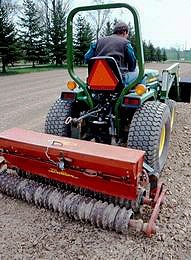
Seeding the meadow
Photo: © Y.Cunnington
March 2000: Paul Jenkins assesses our site and feels that it is weed-free enough after the soybean crop to plant that spring. (He normally advises fall planting because most sites require a season of tilling or application of herbicides to clear them of weeds before planting.)
Mid- to late April: We prepare the site ourselves with a rented tractor-pulled tiller and then smooth it with a harrow.
Early May: Paul arrives with the seed and Brillion seeder to do the sowing. His seeder has two compartments, one for flower seeds, and second for the grass seed, which is fluffier.
At the same time, grass seed (we chose Eco-Lawn, a low maintenance mixture of fescues, also supplied by Wildflower Farm) is planted around the meadow area and in the rest of the field.
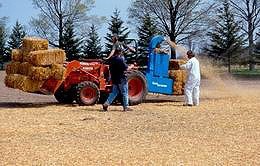
The seeded area is mulched with straw
Photo: © Y.Cunnington
After seeding, Paul and his team mulch the area with straw, which serves two purposes, to keep the soil moist and help prevent germination of annual weeds.
Late May into June: We are lucky and have plenty of rain so the seeds germinate after a few weeks. (The previous season had been one of severe drought, so lack of moisture was a concern, as we had no way to irrigate the field.)
Related Information
Wildflower gardening resources




